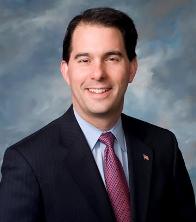Scott Walker Faces Bleak Historical Odds in 2018 Bid
Wisconsinites have elected a governor from the sitting president’s party just five times out of the last 32 elections since 1932

Several Republican governors running for reelection reside in blue Northeastern states, but high approval ratings make them strong favorites to win another term. The most recent Morning Consult poll finds Republicans Charlie Baker of Massachusetts (69 percent), Larry Hogan of Maryland (67 percent), and Phil Scott of Vermont (63 percent) all boasting approval ratings ranking in the Top 5 from across the nation.
One GOP governor on the ballot this November who is not in as enviable a position is Wisconsin’s Scott Walker – sitting at just a 43 percent approval rating with his electorate according to Morning Consult and seven points underwater with 50 percent disapproving of his job performance.
Walker trails only Illinois’ Bruce Rauner (24 points underwater) as the country’s least popular Republican gubernatorial incumbent on the ballot this year.
If he is victorious in 2018, Walker will tie Wisconsin’s record of four gubernatorial victories joining fellow Republican Tommy Thompson.
However, Walker faces an electorate that has been notorious for voting against the party of the sitting president in gubernatorial elections dating back nearly a century.
Wisconsin is currently tied for the fourth largest such streak in the nation – electing a governor from the opposing party of the sitting president in seven consecutive elections.
Wisconsin’s streak began in 1994 with Bill Clinton in office as Governor Thompson won his third term during a national Republican wave. The Badger State elected Thompson again in 1998 with Walker victorious three times (2010, 2012, 2014) during Barack Obama’s presidency.
Meanwhile, Democrat Jim Doyle was elected in 2002 and 2006 with Republican George W. Bush in office.
Wyoming leads the nation at nine gubernatorial wins in a row by a nominee from a different party than the president dating back to 1982 with Tennessee (1986) and New Jersey (1989) next at eight straight.
The streaks in Wyoming and Tennessee are likely to end this November with Republicans heavily favored to hold the open seats of Matt Mead and Bill Haslam respectively.
Like Wisconsin, Kansas (since 1990), New Mexico (1990), and Oklahoma (1990) have also failed to elect governors from the party of the sitting president for seven straight cycles.
The numbers do not get much better for Walker taking a deeper dive into the 20th Century.
Overall, Wisconsinites have elected a gubernatorial nominee from the sitting president’s party in just five of the last 32 elections dating back to 1932, or 15.6 percent of the time.
Democrats have endured a particularly woeful record during this 85+-year span, winning only one of 20 such races.
The party’s lone victory came in 1962 when Attorney General John Reynolds defeated former state party chairman (and 1960 GOP nominee) Philip Kuehn by less than 12,000 votes (0.9 points) with John Kennedy in the White House.
Republicans have fared only slightly better, winning the governor’s mansion only 33 percent of the time with a GOPer in the Oval Office (four of 12 races):
- 1954 (Dwight Eisenhower): Two-term Governor Walter Kohler, Jr. beat former state assemblyman and 1952 nominee William Proxmire by 3.1 points in a rematch election
- 1956 (Eisenhower): Attorney General Vernon Thompson defeated Proxmire by 3.8 points
- 1986 (Ronald Reagan): State Assemblyman Tommy Thompson unseated Governor Tony Earl by 6.5 points
- 1990 (George H.W. Bush): Governor Thompson won a second term with a 16.4-point win over Assemblyman Tom Loftus
Wisconsin’s decades-long tradition of being a gubernatorial naysayer plus lackluster approval ratings for both Governor Walker and Donald Trump in the state would appear to put Democrats in a strong position to pick up the seat this cycle.
However, there are two factors working in Walker’s favor heading into 2018.
First, the Democratic field is currently so overcrowded with candidates that it is possible the winning nominee will have to spend a significant amount of money prior to his or her general election campaign.
One would expect Democrats to eventually settle on three-term Superintendent of Public Instruction Tony Evers – the only announced candidate who has previously won a statewide race.
Secondly, gubernatorial incumbents have notched a decent record at the ballot box over the decades in Wisconsin – winning 36 of 51 elections since statehood, or 70.6 percent of the time. [Three of these losing incumbents – all Republicans – were defeated during the primary: Fred Zimmerman in 1928 to Walter Kohler, Sr., Kohler in 1930 to Philip La Follette, and La Follette in 1932 to Kohler].
However, incumbents have only two recorded wins in eight attempts since 1932 when their party runs the White House: Kohler in 1954 and Thompson in 1990.
La Follette (1932), Democrat Albert Schmedeman (1934), Republican Vernon Thompson (1958), Democrat John Reynolds (1964), Democrat Martin Schrieber (1978), and Republican Scott McCallum (2002) all came up short.
Follow Smart Politics on Twitter.

Another factor that may work in favor of Walker is the fact that he is seemingly always on his (political) toes; for this, the organised labor within the state is arguably to be blamed, namely the recall election of 2012 (TWO elections within a single four-year cycle), regarded even by some partisan Ds as an intemperate and petulent move. Too, the demographics of the state, namely the proportions of both metro and non-caucasian voters, ought to bolster Walker: Its Latino and black voting base is modest, even wan, compared to NV or AL; and, neither the resolutely Democratic Milwaukee nor the militantly left-leaning Madison region possesses a sufficient electoral weight against the (Crimson-hued) hinterland, the way the Northern Virginia, Denver, or Twin Cities regions do within their respective states.